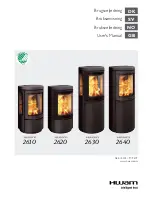
JINECO02 RevG 11/06/12
Fireguards
Always use a fireguard in the presence of
children, the elderly or the infirm. The fireguard
should be manufactured in accordance with
BS8423 – Fireguards for use with solid fuel
appliances.
Do not Over-Fire
It is possible to fire the stove beyond its design
capacity. This could damage the stove so watch
for signs of over-firing.
If any part of the stove starts to glow red, the
stove is in an over-fire situation and the
controls should be adjusted accordingly.
Never leave the stove unattended for long
periods without first adjusting the controls to a
safe setting.
Careful air supply control should be exercised at
all times.
Fume Emission
Properly installed and operated, this appliance
will not emit fumes. Occasional fumes from de-
ashing and refuelling may occur. Persistent
fume emission must not be tolerated.
This appliance should not be operated with the
door open
If fume emission does persist then the following
action should be taken immediately –
Open doors and windows to ventilate room.
Let the fire out, or eject and safely dispose
of fuel from the appliance.
Check for flue/chimney blockage and clean
if required.
Do not attempt to relight the fire until the
cause has been identified and corrected.
If necessary seek professional advice.
Adverse Weather
In a small number of installations, occasional
local weather conditions (e.g. wind from a
particular direction) may cause downdraught in
the flue, causing the stove to emit fumes.
In these circumstances the stove should not be
used. A professional flue installer can advise on
solutions to this problem.
Do not fit an extractor fan in the same room as
this appliance.
In the Event of a Chimney Fire
Raise the alarm
Call the Fire Brigade
Close appliance air controls
Move furniture, ornaments etc away
Place a fireguard in front of stove
Check the chimney breast for signs of
excessive heat.
Ensure the Fire Brigade can gain access to your
roof space in order to check for fire spread.


































